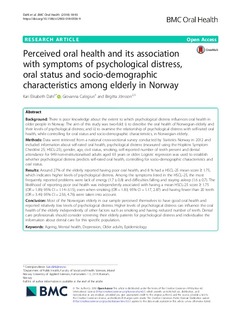| dc.contributor.author | Dahl, Kari Elisabeth | |
| dc.contributor.author | Calogiuri, Giovanna | |
| dc.contributor.author | Jönsson, Birgitta | |
| dc.date.accessioned | 2019-03-08T08:47:00Z | |
| dc.date.available | 2019-03-08T08:47:00Z | |
| dc.date.created | 2018-09-10T16:21:38Z | |
| dc.date.issued | 2018 | |
| dc.identifier.citation | BMC Oral Health. 2018, 18 (1), 93-?. | |
| dc.identifier.issn | 1472-6831 | |
| dc.identifier.uri | http://hdl.handle.net/11250/2589283 | |
| dc.description | Open Access This article is distributed under the terms of the Creative Commons Attribution 4.0 International License (http://creativecommons.org/licenses/by/4.0/), which permits unrestricted use, distribution, and reproduction in any medium, provided you give appropriate credit to the original author(s) and the source, provide a link to the Creative Commons license, and indicate if changes were made. The Creative Commons Public Domain | |
| dc.description.abstract | Background There is poor knowledge about the extent to which psychological distress influences oral health in older people in Norway. The aim of this study was two-fold: i) to describe the oral health of Norwegian elderly and their levels of psychological distress; and ii) to examine the relationship of psychological distress with self-rated oral health, while controlling for oral status and socio-demographic characteristics, in Norwegian elderly. Methods Data were retrieved from a national cross-sectional survey conducted by Statistics Norway in 2012 and included information about self-rated oral health, psychological distress (measured using the Hopkins Symptom Checklist 25; HSCL-25), gender, age, civil status, smoking, self-reported number of teeth present and dental attendance for 949 non-institutionalised adults aged 65 years or older. Logistic regression was used to establish whether psychological distress predicts self-rated oral health, controlling for socio-demographic characteristics and oral status. Results Around 27% of the elderly reported having poor oral health, and 8 % had a HSCL-25 mean score ≥ 1.75, which indicates higher levels of psychological distress. Among the symptoms listed in the HSCL-25, the most frequently reported problems were lack of energy (1.7 ± 0.8) and difficulties falling and staying asleep (1.6 ± 0.7). The likelihood of reporting poor oral health was independently associated with having a mean HSCL-25 score ≥ 1.75 (OR = 1.89; 95% CI = 1.14–3.15), even when smoking (OR = 1.83; 95% CI = 1.17, 2.87) and having fewer than 20 teeth (OR = 3.49; 95% CI = 2.56, 4.76) were taken into account. Conclusion Most of the Norwegian elderly in our sample perceived themselves to have good oral health and reported relatively low levels of psychological distress. Higher levels of psychological distress can influence the oral health of the elderly independently of other factors such as smoking and having reduced number of teeth. Dental care professionals should consider screening their elderly patients for psychological distress and individualise the information about dental care for this specific population. | |
| dc.description.abstract | Perceived oral health and its association with symptoms of psychological distress, oral status and socio-demographic characteristics among elderly in Norway | |
| dc.language.iso | eng | |
| dc.title | Perceived oral health and its association with symptoms of psychological distress, oral status and socio-demographic characteristics among elderly in Norway | |
| dc.type | Peer reviewed | |
| dc.type | Journal article | |
| dc.description.version | publishedVersion | |
| dc.source.pagenumber | 93-? | |
| dc.source.volume | 18 | |
| dc.source.journal | BMC Oral Health | |
| dc.source.issue | 1 | |
| dc.identifier.doi | 10.1186/s12903-018-0556-9 | |
| dc.identifier.cristin | 1608206 | |
| cristin.unitcode | 209,4,3,0 | |
| cristin.unitname | Institutt for folkehelse | |
| cristin.ispublished | true | |
| cristin.fulltext | original | |
| cristin.qualitycode | 1 | |
